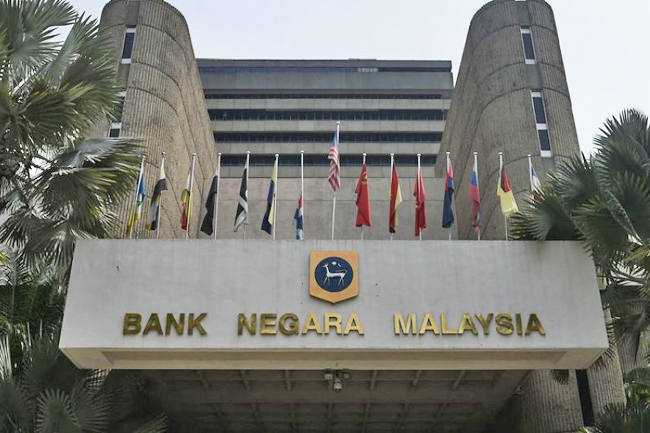ANN/THE STAR – If the 24 per cent reciprocal tariff by the United States (US) on Malaysia were to take effect in the near term, this will increase the likelihood of Bank Negara revising the benchmark lending rate – the overnight policy rate (OPR).
Most experts, however, said the central bank is unlikely to cut rates based solely on tariffs, as there are other factors to be taken into account.
On April 2, the US government launched baseline tariffs of 10 per cent on all imports to the US and reciprocal tariffs on trade partners on April 9.
In the latest twist on the tariff saga, the US now said it will impose a 10-per-cent tariff for 90 days on more than 75 countries that were willing to negotiate with the US. Negotiations during the tariff pause will decide whether tariffs on Malaysia would be lifted, maintained at 24 per cent or reduced.
The OPR was maintained at three per cent at the bank’s Monetary Policy Committee (MPC) meeting in March. The benchmark lending rate has remained unchanged since May 2023.
Economist Anthony Dass told StarBiz if the 24- per-cent reciprocal tariff is maintained on Malaysian imports, coupled with broader global tariff retaliation and rising geopolitical uncertainty, the probability of Bank Negara adjusting its monetary policy stance in 2025 has increased.
“While the OPR is currently maintained at three per cent, downside risks from escalating trade headwinds could warrant a reassessment should external shocks significantly weaken the macroeconomic outlook,” he noted.
Dass, who is the senior economic adviser at KSI Strategic Institute for Asia-Pacific and also the Malaysian Institute of Economic Research (MIER) executive director, however, said the central bank is unlikely to pre-emptively lower interest rates in response to US tariffs alone.

Any monetary easing would likely be conditional upon various factors, he said.
They include a sustained and broad-based deterioration in export performance and foreign direct investment (FDI) inflows, a subdued inflation environment or clear disinflationary trends, and a stable ringgit without heightened volatility that could destabilise capital markets or erode investor sentiment.
For now, he said domestic demand remained the primary engine of growth for Malaysia in 2025. The outlook is supported by a healthy labour market, steady wage gains, accommodative fiscal measures and continued momentum in infrastructure spending.
“Nonetheless, escalating external headwinds – especially from tit-for-tat tariffs and shifting global supply chains – pose meaningful downside risks to net exports, private investment and foreign capital flows.
“That said, resilience is expected from ongoing large-scale public infrastructure projects, direct fiscal transfers to lower-income groups and a continued recovery in tourism.
“These buffers, however, may not be sufficient to fully offset the broader drag from a deteriorating global trade environment,” Dass said, adding that he had revised the 2025 gross domestic product (GDP) growth forecast downward, from 4.5 per cent to 5.5 per cent to a range of four per cent to 4.9 per cent. The GDP growth target for this year is between 4.5 per cent and 5.5 per cent versus 5.1 per cent in 2024.
OCBC Bank senior Asean economist Lavanya Venkateswaran said the downside risks to growth have risen from these tariffs.
This is as central banks globally and Bank Negara are faced with a high degree of uncertainty.
“The first course of action during volatile times is to prevent a further backsliding of sentiment, and handle the foreign-exchange market volatility.
“Monetary policy support could follow once it’s clear that growth and the real economy have been hit.
“The OPR cannot directly address any trade-related issues. The issues at hand are related to the fundamental dynamics of the economy and the trade with the US.
“The role of the OPR can be one of the tools of counter-cyclical support once it’s clear that economic growth will be impacted,” she said.
Venkateswaran said domestic demand in terms of already planned investments and near-term household spending would likely hold up, while exports to the US would continue to be frontloaded as reciprocal tariffs are delayed.
Furthermore, she said the government’s clear medium-term agenda for crucial sectors such as semiconductors would provide a buffer to growth.
In addition, she said plans to broaden the growth base beyond Selangor and Penang into Johor, diversifying trade partners are also positives for the growth trajectory.
Centre for Market Education Chief Executive Officer (CEO) Carmelo Ferlito reckoned that, under the current circumstances and with potential tensions on the ringgit, lowering the interest rate would be ineffective, if not even harmful.
“Gradually, the actual intentions of the US government it seems to me is that the ultimate goal is not the tariff per se but forcing trading nations back at the discussion table with the US for them to regain a prominent role in the international trade scenario,” he said.
Ferlito said under the current scenario, the main GDP component to keep under observation is international trade, to assess if import and export trends change. But it is early to say at this juncture and would have to wait to see the actual US game plan and the local reaction, he said.
Bank Muamalat Malaysia Bhd Chief Economist Mohd Afzanizam Abdul Rashid said monetary policy has always been the first line of defence when it comes to stabilising economic growth.
“Bank Negara has built its policy space and given the risks of inflation are fairly contained, a 25 basis points cut in OPR is appropriate in my view. Perhaps it might happen in the second half of the year, possibly in the July meeting.
“There is always a chance that the central bank might want to lower the OPR as the tariff would compromise the outlook on Malaysia’s export. Given that the exports to the US accounted for 13.2 per cent of total exports, and it is the second largest export market, any reduction in demand would be a material event to the local economy,” he said.
Mohd Afzanizam added that the bank has revised its GDP forecast from 4.7 per cent to 4.1 per cent.


